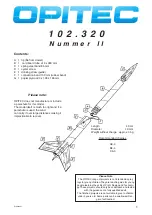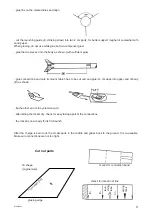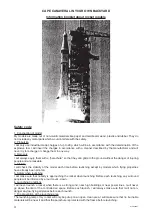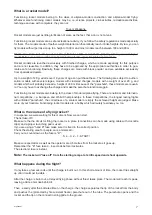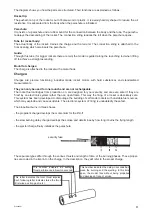
5
E102320#1
8. Heat-resistant shield
The launching ramp of my rocket will always be equipped with a heat-resistant shield which will prevent that
the jet beam hits the ground.
9. Launching guide
ln order to prevent eye injuries, I put a safety cap on the tip of the rocket which will not be removed until im-
mediately before the launch. When the launching ramp is not in use, it is stored with the rod horizontally.
10. Pouer lines
I will never try to recover my rocket when caught on a power line or other dangerous places.
11. Launching angle
The launching angle of my rocket will never vary by more than 30° from the vertical position. My rockets are
no weapons. They will not be aimed at any targets on the ground or in the air and they do not carry any explo-
sives.
12. Home-made rockets
I will always test home-made rockets for their dependability and flying characteristics before launching for the
first time. When launching home-made rockets for the first time, I will make sure that only persons who take
part in the launch will be present.
13. Satutory Regulations
According to the Explosives Law, charges for rockets are pyrotechnical objects of the lower class T1 for tea-
ching and sports purposes. lt is known to me that juveniles between 14 - 18 years of age may only install and
light the charges in the presence of a guardian and that it will only be allowed in a sports or technical club in
the presence of or with the written permission of tho legal guardian.
Cildren under the age of 14 must not install or light charges!
Do not entrust charges to a person under the age of 18!
Preparation for launch
In order to keep track of all the details, you should make your preparations according to the standard count-
down used in rocketry. The systematic sequence, until the time of ignition, is described in the assembly in-
structions.
One very important aspect, which is often neglected, is the choice of a suitable area for the launch. It has to
be away from trees, tall buildings and power lines. In practice, you often have to make compromises as far as
to the area. The smallest permitted area should cover at least 1/4 of the expected height.
NOTE:
The owner of the property has to give permission for the launch.
When launching the rockets from small areas, it is important to choose the most suited charge. Otherwise,
you will have to search for a long time for the rocket when Iaunching on a windy day.
The lowest limit of the controlled air space - 330 m - (in the vicinity of airports, this air space is all the way to
the ground) must not be exceeded. This is a regulation which must be observed, especially near airports (mi-
nimum distance 1,5 km from the borders of the airport during hours of operation).
The parachute has to be packed so tightly, that it can easily be ejected. Nevertheless, it should not be folded
in order to prevent failures. The best way to do this is to hold it in the middle and stroke it back gently, then
fold or roll it and wrap the connection string around it.
DON'T FORGET TO ADD THE PROTECTION FLEECE!!
Parachute
It is important that the model gets back to the ground safely after each launching. This is done by the parachu-
te. Following are the three most common systems.
Содержание 102.320 Nummer II
Страница 10: ...10 E102320 1...

